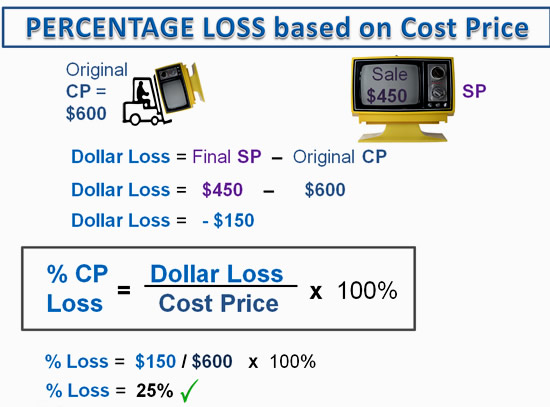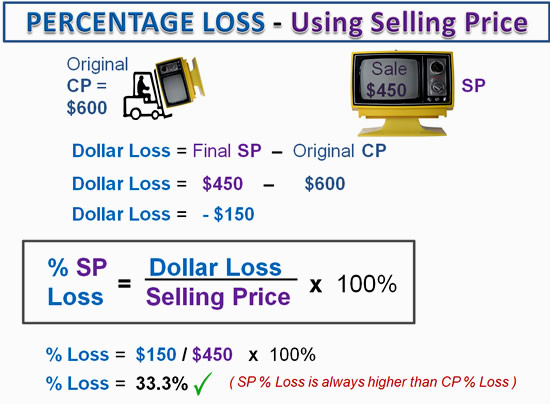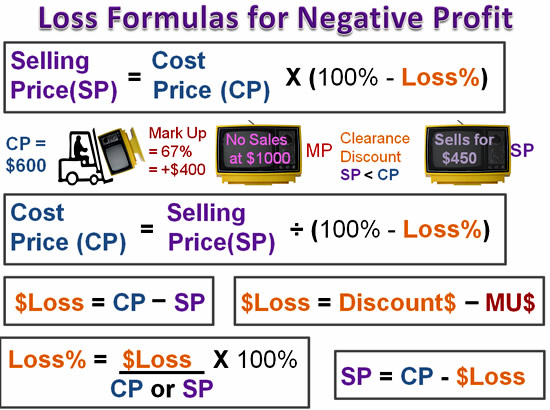
Image Source: http://charlesandhudson.com
In a previous lesson we looked at how Retailers place “Mark Ups” on items so that they can make a Profit on the sale.
It is important that you have viewed this lesson before doing the contents of our Loss Lesson.
The Mark Up and Profit Lesson can be viewed by clicking the link below:
http://passyworldofmathematics.com/cost-price-mark-up-and-profit/
Definitions for Items in Formulas
Cost Price
The Cost Price is how much it costs a retailer to buy items they are going to sell from suppliers or from overseas.
Mark Up
The Mark Up is extra money that the retailer adds on before putting a final price on the item.
Marked Price
This is the final price of the item. The Marked Price is then written onto the tag or sticker that is put onto the item in the shop.
This is the price the customer has to pay for the item and is also often called the full “Recommended Retail Price” or “RRP”.
If the item is NOT on discounted sale, then the customer has to pay the full RRP that is on the item’s tag or sticker.
Discount
If the shop is having a Sale, you do not have to pay the full Marked Price on the item. This is because the retailer gives you some money off the full normal price to create a lower than normal “Sale Price”.
Sale Price
The Sale price is the price the customer ends up paying for the item.
If the item is on sale for a discounted price, the Sale Price (sometimes called the “Selling Price”), will always be lower than the full normal Marked Price.
But if the item is not on sale, the customer will have to pay the full normal Marked Price.
Profit
Retailers sell items for more than it cost to get them, (even when the items are on Discount Sale). This allows the Retailer to make some money.
The money that the retailer makes from selling the item is called the “Profit”.
Loss
Sometimes a retailer will get into money problems, or have more items than they can fit in their shop or warehouse.
When this happens they have to sell goods at desperately low prices to get money to pay for shop rent, wages, electricity, transport, etc.
If they do not take this desperate step, they will get into huge debt and go out of business.
If they have to sell an item for less money than it originally cost them, then they will lose money on that item.
Losing money on a sale because the Sale Price is really really low, is called “Making a Loss”.
Dollar Loss

Image Source: http://www.star1045.com.au
Tommy and Tamara buy 100 “Retro TVs” at a Cost Price of $600 each.
They thought these TVs would be a real hit with young people and priced them with a Marked Price of $1000 each.
However, after two months they had only sold one TV set, and the other 99 TVs were taking up valuable space in their store room and gathering dust.
They then had to make the sad decision to sell the TV’s in a clearance sale at below cost with a Sale Price of $450.
This means that they do not make any Profit on each TV, instead they make a loss.

Image Copyright 2013 by Passy’s World of Mathematics
Percentage Loss
Just as we covered with “Profit” in a previous lesson, there are two ways to calculate Percentage Profit and Percentage Loss.
There are two ways businesses use to express Percentage Loss:
1) Percentage Loss based on the Cost Price
and
2) Percentage Loss based on the Selling Price
This can be very confusing for people new to Financial Mathematics. The trick is to read the given question or situation very carefully.
If the question just asks for “Percentage Loss” (and does not specify based on Selling or Cost), then calculate the Percentage Loss based on the Cost Price.
Shown below is how we calculate the Percentage Loss based on the Cost Price:

Image Copyright 2013 by Passy’s World of Mathematics
Shown below is how we calculate the Percentage Loss based on the Selling Price

Image Copyright 2013 by Passy’s World of Mathematics
Selling Price with Loss Formulas
We calculate the Selling Price for items which are being sold at a Loss as follows:

Image Copyright 2013 by Passy’s World of Mathematics
Note that the above formulas are written in a format which should aloow direct entry of values into pocket calculators.
Loss Formulas Summary
Here are the main formulas we use for working with Losses.

Image Copyright 2013 by Passy’s World of Mathematics
These need to be copied down into the maths notes for Losses in your workbook.
Profit and Loss Video
Here is a very comprehensive video about Profit and Loss with plenty of example questions in it.
Related Items
In our previous lesson we covered Cost Price, Mark Up, and Profit. Click the link below to check out this lesson.
http://passyworldofmathematics.com/cost-price-mark-up-and-profit/
Help Passy’s World Grow
Each day Passy’s World provides hundreds of people with mathematics lessons free of charge.
Help us to maintain this free service and keep it growing.
Donate any amount from $2 upwards through PayPal by clicking the PayPal image below. Thank you!
PayPal does accept Credit Cards, but you will have to supply an email address and password so that PayPal can create a PayPal account for you to process the transaction through. There will be no processing fee charged to you by this action, as PayPal deducts a fee from your donation before it reaches Passy’s World.
If you enjoyed this lesson, why not get a free subscription to our website.
You can then receive notifications of new pages directly to your email address.
Go to the subscribe area on the right hand sidebar, fill in your email address and then click the “Subscribe” button.
To find out exactly how free subscription works, click the following link:
If you would like to submit an idea for an article, or be a guest writer on our website, then please email us at the hotmail address shown in the right hand side bar of this page.
Feel free to link to any of our Lessons, share them on social networking sites, or use them on Learning Management Systems in Schools.
Enjoy,
Passy


